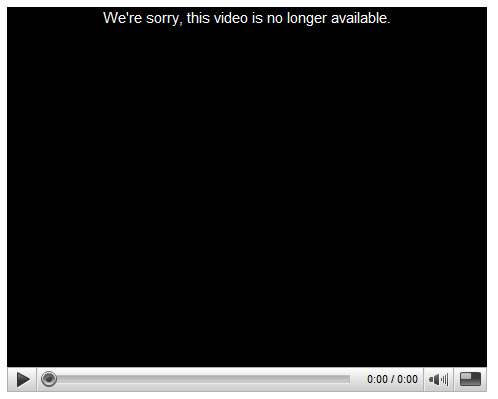What started as a trickle of a problem a few months ago has bubbled over into a series of unfortunate, unstoppable, unbearable and unbelievable events in the life of a successful startup that has perhaps become too big for its boots.
Two months ago, I noticed that every fifth or sixth blog I visited that included an embedded YouTube video would display a single white line of text after clicking the play button. “We’re sorry, this video is no longer available”.

This was obviously a pretty big deal. ‘No longer available’ implied that YouTube had deleted the video, possibly because it had violated one of their highly publicised copyright infringement conditions. At the time, I simply ignored the video portion of the castrated blog post and moved swiftly on.
But a few days later, after noticing that the frequency of this message was quickly increasing, and having found a video that I really wanted to see, I clicked the YouTube logo in the corner of the embedded player to get back to the original video post. While waiting for the page to load, I was sifting through the possible reasons for this seemingly non-offensive video being unavailable. When the page appeared, the most extraordinary thing happened. The video started playing. No mention of it being unavailable at all. In fact, the comments underneath the player were as recent as an hour or two before.
This was intriguing. Why would an enormously successful, somewhat spoilt, adopted child of Google’s deliver such conflicting user experiences? I started digging, seeking out blogs or sites with embedded YouTube videos. Surprisingly, 80% of the videos on the sites I found were ‘unavailable’ in the embedded player but perfectly presentable on YouTube’s own site. This wasn’t a needle in a haystack. This was serious. And, after extending the amateur investigation into a week-long snoop, I came to the conclusion that YouTube was trying to force users to visit YouTube.com to view their videos.
A bit of a cheek, I thought, but something that would probably resolve itself as a non-event when the head honchos had received enough complaints to prod them into retracting their vicious plan.
But, as most of the planet now knows, the situation is a lot more serious than my previous investigations had revealed. This problem is no longer limited to embedded videos. It now affects just about any video, in any YouTube session, for any visitor, using any browser. Loading a YouTube video has now become a major chore, requiring at least a few page refreshes (and peer-to-peer help in times of sheer desperation). It has prompted discussions, debates, blog posts and questions across the the web.
Now, while the world happily refreshes YouTube videos in a never ending spree, one of two things is happening here. Either:
YouTube has grown too big and too fast, leaving the thousands of Google employees unable to deal with the traffic by optimizing resources. This is highly, hugely, grossly unlikely. A company that builds hundreds of services, dealing with billions of queries per day, is surely in control of sufficient financial and human capital to knock this problem on the head. or
YouTube is doing this on purpose. They must be. If not, why would they not simply change the alert from ‘We’re sorry, this video is no longer available’ to ‘We’re sorry, this video is not available right now’? Why mislead users?
This is the interesting bit, because there are two possible answers. Or one answer, if both of them apply.
They’re balancing and rationing their output. A viewer:video ratio of some sort. So at any one second in time, 40% of users will see the ‘no longer available’ alert. As they click refresh, some of them see the video, while those of the previous 60% with access are then blocked when trying to click on the next video. The conspiracy-theorist-capitalist in me thinks that this smacks a bit of visit manipulation. In other words, the more people who have to visit YouTube.com (because embedded videos only play one out of five times), the more people have to refresh each video page three to ten times, the more views each video racks up. Inflated views = inflated ad impressions = greater monetisation. Et voila, YouTube races towards the profit line.
There are a few alternative browsers that have been known to deliver a more reliable YouTube experience, but for how much longer? And even if this is the case, why is YouTube inconveniencing 95% of the connected population? If you’re embedding videos you’ve uploaded to YouTube, can you really expect your users to go to the trouble of finding the original on YouTube.com and going into a refreshing cycle of note until they finally hit the jackpot?
Already, users are actively seeking out alternatives to YouTube. You would think that this notion alone would frighten the big kahunas in Mountain View enough to do something about the situation.
But if they continue to do nothing, say nothing and fix nothing, you might want to think about why.


